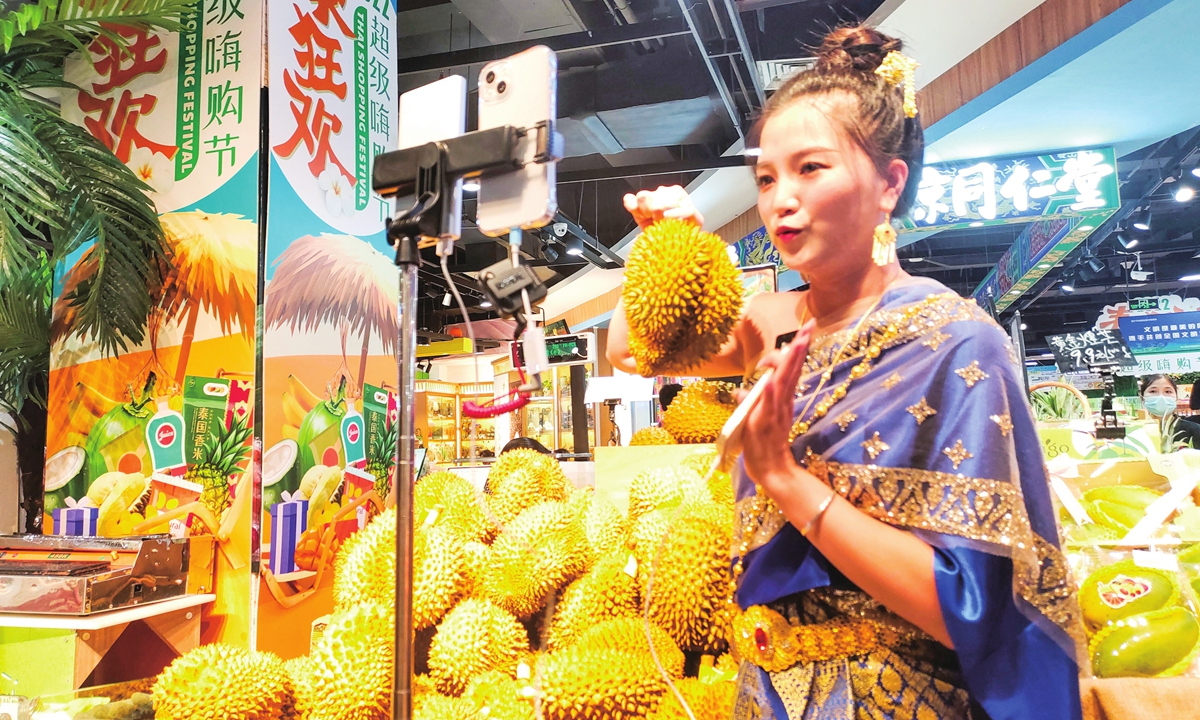
Sales staff shows durian imported from Thailand. Photo: VCG
The 20th China-ASEAN Expo (CAEXPO), an annual trade show which aims to facilitate economic cooperation between China and ASEAN, will be held from September 16 to September 19 in Nanning, South China's Guangxi Zhuang Autonomous Region, with the exhibition's scale bouncing back to pre-virus levels, Chinese officials said on Friday.
The expo carries great significance as this year marks the 10th anniversary of the China-proposed Belt and Road Initiative (BRI) - under which ASEAN has become a pilot demonstration zone for the initiative's development - as well as a closer China-ASEAN community with a shared future.
The expo this year is themed "Building a harmonious homeland, a common destiny to the future - promoting high-quality development of BRI and building an economic growth center," Vice Minister of Commerce Li Fei said at a press briefing of the State Council Information Office on Friday.
He noted that during the past 20 years, the trade fair has become an important open cooperation platform for the two economies, while also playing a positive role in regional economic integration.
This year, over 40 countries and 1,700 companies are expected to participate in the fair, Sui Guohua, vice governor of Guangxi, said at the Friday press briefing. The exhibition area for foreign companies accounts for 30 percent of the total area.
"A number of accompanying conferences will also be held, aiming to promote economic and trade cooperation between China and ASEAN, and to provide new impetus to the regional economic recovery and global development in the post-virus era," Sui said.
Sui estimated that boosted by those facilitation activities, project deals worth over 400 billion yuan ($54.88 billion) will be signed, of which manufacturing projects will account for over 40 percent.
The expo also marks the second edition of the event since the Regional Comprehensive Economic Partnership (RCEP) went into force at the beginning of 2022. In 2021, China and ASEAN elevated their ties to a comprehensive strategic partnership.
"The implementation of RCEP has provided new opportunities for trade and investment cooperation between China and ASEAN, with policy dividends being released," Li said.
The vice commerce minister noted that the two sides are facilitating the negotiation of the China-ASEAN Free Trade Agreement 3.0, which is expected to raise the opening-up level of bilateral trade and investment area, expand beneficial cooperation in new emerging sectors such as digital economy, green economy and supply chain connectivity.
In 2022, bilateral trade between China and ASEAN grew 11.2 percent year-on-year to $975.3 billion, growing 1.2 times during the past 10 years. China-ASEAN trade accounted for 15.5 percent of China's foreign trade in 2022. Accumulated two-way investment also surpassed $380 billion among China and ASEAN members as of July 2023, official data showed.
In the current grim situation of global trade, which faces multiple risks such as recession in developed economies and artificial "decoupling," China-ASEAN economic and trade relations adhere to innovation and scientific and technological progress, which allow them to continue to optimize the supply chains and cross-border trade platforms, Chen Jia, an independent analyst on global strategy, told the Global Times.
Multilateral frameworks such as BRI and RCEP provide cooperation opportunities in infrastructure construction and connectivity between China and ASEAN members, Wang Jianjiao, research fellow with Silk Road Academy of Social Sciences, told the Global Times.
"The Silk Road Academy of Social Sciences judged that from 2023 to 2025, new energy projects of China and ASEAN members will continue to see an increase, of which the energy and transportation fields are the focus. Meanwhile, there is still a large space for development cooperation in new infrastructure," said Wang.
For example,
Chinese new-energy vehicle producers, including BYD Auto, Changan Automobile, Great Wall Motors and Hozon Auto, have expanded their manufacturing bases in Thailand in recent months.Opportunities for cooperation also exist in areas such as artificial intelligence, financial technology and e-commerce, Wang noted.




